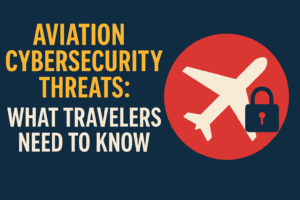Introduction

The skies may be clear, but there’s chaos behind the scenes and it’s not just about the weather.
One of the world’s most dangerous hacker groups has its sights set on the aviation industry, according to a recent FBI statement. Airlines, airports, and aviation related software are now facing serious cybersecurity threats, with experts warning that passengers, operation, and data are all at risk.
This isn’t science fiction or a Hollywood plot, it’s real, and it’s already happening.
With modern aircraft systems, ticketing services, and airport operations relying so heavily on technology, the stakes are incredibly high. A timely cyberattack could delay fights, disrupt services, or even expose sensitive passenger data. The FBI’s warning signals a dangerous trend that every traveler, airline executive, and airport employee should be paying close attention to.
In this in-depth article, we’ll break down:
- Who is the hacker group?
- Why aviation is a prime target?
- Real-world events
- What’s being done?
- What travelers like you should do right now
Stay informed. Stay safe.
Who is This Hacker Group?

The FBI’s latest bulletin doesn’t directly name the group, but cybersecurity experts believe it’s likely linked to FIN7, APT28, or similar Advanced Persistent Threat (APT) actors, group that have previously been linked to high profile ransomware and cyberespionage campaigns.
These aren’t your average basement hackers. We’re talking state-sponsored or well funded cybercriminals with access to high end equipment, insider information, and experience breaching high-end systems. Their past targets include:
Major U.S. corporations
Critical infrastructure like power grids
Government agencies
Healthcare and financial institutions
Now, they’ve turned their attention to aviation, which involves complex infrastructure, large amounts of user data, and real time services a hacker’s dream.
A related trend is the use of phishing campaigns to infiltrate airline employees’ emails. From there, they can install malware, gain access to internal systems, and even launch ransomware attacks.
These groups often follow a patient, consistent pattern, silently entering systems, mapping the digital landscape, and waiting for the perfect moment to strike. And once they do, the impact can spread across borders.
Why the Aviation Industry Is a High Value Target

The aviation industry is more than just planes in the sky. It’s a global network of sophisticated systems, real-time operations, and sensitive customer data making it a goldmine for hackers.
Here’s why cybercriminals are zeroing in:
🧠1. Massive data storage
Every airline and airport collects troves of data from passport details and payment methods to frequent flyer accounts and travel itineraries. This type of personally identifiable information (PII) can be sold on the dark web or used in identity theft and financial fraud.
📡2. Complex, Interconnected Systems
Modern airlines operate on integrated digital ecosystems that include:
- Flight control systems
- Crew scheduling software
- Ticketing platforms’
- Ground logistics
- Airport security networks
If one node is compromised, it can start a chain reaction that brings down entire operations.
💰3. Financially Iucrative ransomware targets
Airlines can’t afford to be down for hours, let alone days. That makes them more likely to pay ransoms to get systems back online, which is exactly what ransomware gangs bank on.
A well placed ransomware attack can lock pilots out of flight plans or restrict access to boarding systems. Imagine a hacker freezing the check in system at a major international airport — chaos ensues.
🕵️ 4. National Security Impact
Give aviation’s role in global transportation and defense, a breach could be more than just an inconvenience. It could jeopardize national security, making the industry a top priority for state sponsored attackers.
🏢 5. Legacy technology still in use
Many airlines and airports still rely on outdated or patched tech stacks. These systems are difficult to secure and often overlooked a perfect storm for cyber attackers.